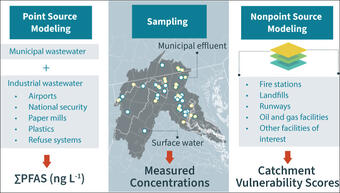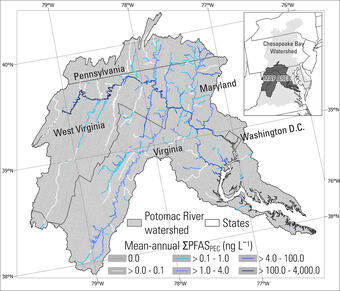Applying Multiple Tools to Inform Management of Per- and Polyfluoroalkyl Substances (PFAS) in the Potomac River Watershed
The reuse of municipal wastewater provides multiple benefits, including maintaining stream flow, recharging aquifers, and providing public water supply. However, along with the benefits are concerns related to the presence of ‘forever’ chemicals, like per- and polyfluoroalkyl substances (PFAS) in wastewater discharge. Managing PFAS in waterways is challenging because there are many potential PFAS sources on the landscape and a large number of individual PFAS which have varying chemical properties and biological effects.
USGS Study
To help managers address complex water-contamination issues related to water reuse, this study provided an understanding of PFAS sources, occurrence, and exposure pathways throughout the Potomac River watershed. These insights were developed by incorporating both field measurements and modeling (fig.1).

Specifically, USGS scientists and their collaborators used two independent screening models to assess PFAS contamination from upstream municipal and industrial wastewater treatment plant (WWTP) discharges for all stream segments in the Potomac River watershed. The team collected water samples from 48 stream sites and 18 municipal WWTP locations. They used the accumulated wastewater ratio (ACCWW) model to predict PFAS concentrations in unsampled stream segments and the Water Sensing and Hydrology for Environmental Decision Support (WaterSHEDS) model to determine PFAS stream-vulnerability scores throughout the watershed.
Major Findings
The research team developed tools to provide a watershed-scale perspective on PFAS contamination from water reuse in the Potomac River watershed. Findings from this study highlighted the diverse sources of PFAS, their hydrologic connection to surface water systems, and potential ecosystem and human exposure pathways.
- Approximately 15% of streams in the watershed contained WWTP discharges that are presumptive PFAS sources. In some streams, WWTP discharge represented greater than 90% of total streamflow.
- Based on the summed concentration of the eight most frequently detected PFAS in WWTP discharge, the average annual predicted environmental concentration for all streams in the watershed was 3.8 nanograms per liter (fig. 2).
- Using the WaterSHEDS model, the team found that 73% of streams in the watershed were at low risk of PFAS contamination, whereas the remaining 27% were at moderate to substantial risk.
- During average low-flow conditions in August, the maximum predicted environmental concentrations of two PFAS exceeded the National Primary Drinking Water Regulation maximum contaminant concentration (4 nanograms per liter) at up to 17% of drinking water-supply intakes in the watershed.
- In 99% of samples, measured environmental concentrations of PFAS were greater than predicted environmental concentrations of PFAS. This finding indicates that WWTP effluent is not the only source of PFAS in the Potomac River watershed.

Management Implications
This study provides water-resource managers with key information about PFAS in public water supplies. Understanding the potential occurrence and sources of PFAS in local streams can help managers design strategies that protect ecosystem and human health. Identifying where and when PFAS concentrations might exceed maximum contaminant concentrations can help inform the operation of drinking water treatment facilities.
The models used in this study are based on publicly available geospatial information. Therefore, this approach can be applied to larger or smaller parts of the Chesapeake Bay watershed to inform PFAS management and research activities. Additionally, the modeling tools used in this study can be applied to address a variety of water-quality issues, including contaminants other than PFAS.
For More Information
The full study is published online with open access: https://pubs.acs.org/doi/10.1021/acs.est.4c12167.
Navigating PFAS Contamination: Insights from the USGS Potomac River Watershed Study
Municipal and industrial wastewater treatment plant effluent contributions to per- and polyfluoroalkyl substances in the Potomac River: A basin-scale measuring and modeling approach Municipal and industrial wastewater treatment plant effluent contributions to per- and polyfluoroalkyl substances in the Potomac River: A basin-scale measuring and modeling approach
The reuse of municipal wastewater provides multiple benefits, including maintaining stream flow, recharging aquifers, and providing public water supply. However, along with the benefits are concerns related to the presence of ‘forever’ chemicals, like per- and polyfluoroalkyl substances (PFAS) in wastewater discharge. Managing PFAS in waterways is challenging because there are many potential PFAS sources on the landscape and a large number of individual PFAS which have varying chemical properties and biological effects.
USGS Study
To help managers address complex water-contamination issues related to water reuse, this study provided an understanding of PFAS sources, occurrence, and exposure pathways throughout the Potomac River watershed. These insights were developed by incorporating both field measurements and modeling (fig.1).

Specifically, USGS scientists and their collaborators used two independent screening models to assess PFAS contamination from upstream municipal and industrial wastewater treatment plant (WWTP) discharges for all stream segments in the Potomac River watershed. The team collected water samples from 48 stream sites and 18 municipal WWTP locations. They used the accumulated wastewater ratio (ACCWW) model to predict PFAS concentrations in unsampled stream segments and the Water Sensing and Hydrology for Environmental Decision Support (WaterSHEDS) model to determine PFAS stream-vulnerability scores throughout the watershed.
Major Findings
The research team developed tools to provide a watershed-scale perspective on PFAS contamination from water reuse in the Potomac River watershed. Findings from this study highlighted the diverse sources of PFAS, their hydrologic connection to surface water systems, and potential ecosystem and human exposure pathways.
- Approximately 15% of streams in the watershed contained WWTP discharges that are presumptive PFAS sources. In some streams, WWTP discharge represented greater than 90% of total streamflow.
- Based on the summed concentration of the eight most frequently detected PFAS in WWTP discharge, the average annual predicted environmental concentration for all streams in the watershed was 3.8 nanograms per liter (fig. 2).
- Using the WaterSHEDS model, the team found that 73% of streams in the watershed were at low risk of PFAS contamination, whereas the remaining 27% were at moderate to substantial risk.
- During average low-flow conditions in August, the maximum predicted environmental concentrations of two PFAS exceeded the National Primary Drinking Water Regulation maximum contaminant concentration (4 nanograms per liter) at up to 17% of drinking water-supply intakes in the watershed.
- In 99% of samples, measured environmental concentrations of PFAS were greater than predicted environmental concentrations of PFAS. This finding indicates that WWTP effluent is not the only source of PFAS in the Potomac River watershed.

Management Implications
This study provides water-resource managers with key information about PFAS in public water supplies. Understanding the potential occurrence and sources of PFAS in local streams can help managers design strategies that protect ecosystem and human health. Identifying where and when PFAS concentrations might exceed maximum contaminant concentrations can help inform the operation of drinking water treatment facilities.
The models used in this study are based on publicly available geospatial information. Therefore, this approach can be applied to larger or smaller parts of the Chesapeake Bay watershed to inform PFAS management and research activities. Additionally, the modeling tools used in this study can be applied to address a variety of water-quality issues, including contaminants other than PFAS.
For More Information
The full study is published online with open access: https://pubs.acs.org/doi/10.1021/acs.est.4c12167.


